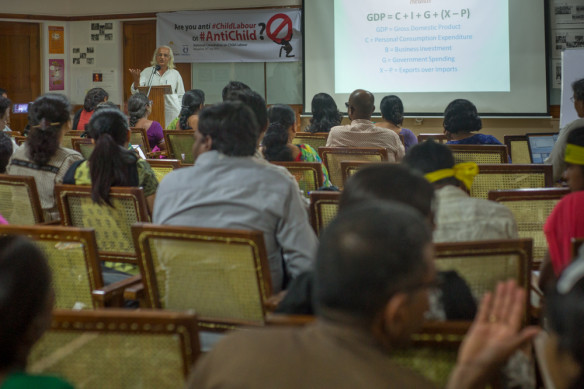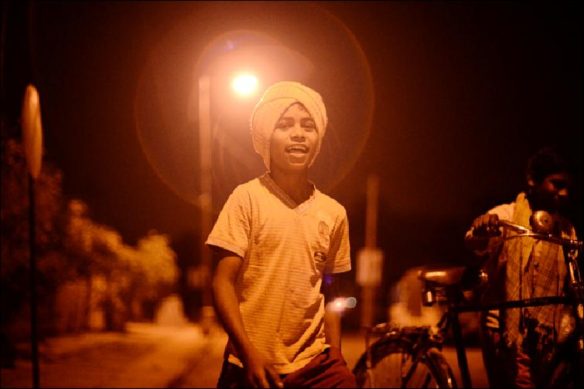Issue 7- July
In this issue:
- National Consultation highlights three decades of a failed child labour legislation
- Members of the Parliament: ‘Don’t be #AntiChild, be Anti #ChildLabour!’
- Critical research and writing
- Recent news
National Consultation highlights three decades of a failed child labour legislation
“The Current system destroys children’s identity of self”; “Is our intervention really going to benefit the children we are setting out to help?”; “Why are they working? What are the underlying causes making children seek work?”– these were some of the statements heard at the national consultation held under the campaign banner of ‘Are you anti #childlabour or #antichild?’ at Ashirwad, Bangalore on the 14th of July 2015. The event was organized by The Concerned for Working Children (CWC) and was attended by a total of 57 participants who represented 27 organisations working in the area of child rights. Prominent members of civil society and the child rights sector in particular were present in the Consultation.
The Consultation began with the premiere of the docu-drama ‘Banned Aid: When protection ends in exploitation’. The docu-drama was a narrative of the experiences of children with the child labour law. It gave an insight into important unanswered questions such as – why do children undertake hazardous work, what happens during and after raids, does the child feel truly rescued? Dramatised by the members of Bhima Sangha (Union of working children), the docu-drama set the tone for the conference. The first session entitled ‘The changing nature of poverty post globalisation’ was taken by Dunu Roy, Director – Hazards Centre (Delhi). He showcased through statistics how the current model of development was hinged on a pattern of industrialisation which painted India as lucrative on the basis of its vulnerable and cheap labour population. He emphatically asked – “Raid and return our children to what?” Child labour remains a symptom of the larger issue of poverty and marginalization which are being perpetuated through a certain model of development that benefits a small section of society.
The panel discussion that followed had four prominent members from the child rights community – Khushboo Jain (social activist), Christopher Williams (International Justice Mission), Fr. Edward Thomas (Former Chairperson KSCPCR) and Arlene Manoharan (Centre for Child and Law, National Law School).
The panel discussed how the current response to the issue of child labour was failing to support children in the short or the long term, instead it was often traumatising them further. Khushboo shared how the system seemed to forget many children such as those living on platforms and how when there was an intervention it ended up doing more harm – “These children are othered. Us adults say we are here to help you but we don’t acknowledge their agency”. Christopher spoke on child trafficking which is banned in India yet has not been resolved and has instead seen an alarming increase. Fr. Edward and Arlene spoke in detail about the current education and the juvenile justice system responses as being poor and ineffective in tackling an issue which is much more complex especially highlighting how children’s inputs were completely missing – “In principle children have the right to be heard. These are glorious words, but not implemented.”
The afternoon session presented by CWC covered the extensive and rich history of the child labour law alongside its own 35 years of engagement. The history indicates that there was a much more nuanced conversation on the issue of child labour in the 1970-80s where it was well recognized that its roots were in poverty and hence a multiple policy approach would be required to support children. The presentation also covered evidence and new research on how the current child labour law was failing to support children. The Child Labour Amendment Bill 2012 follows unthinkingly along the lines of a law which has failed to work for the past almost 30 years. Following this session, child representatives from working children’s union such as Vidiyal, Bhima Sangha, Chiguru and Hasiru Sangha – presented their experiences and perspectives rooted in their difficult realities, through creative methods such as theatre and debate. They poignantly and emotively shared how systems of education and the raid and rescue method – alienate and hurt them. They also shared their varying opinions on child work and discussed amongst themselves issues such as – should children work, can children combine education and work, how do gender roles affect them etc. The audience also added how the law seemed culturally disconnected from the children’s worlds.
These presentations were followed by an intimate sharing and discussion with the audience moderated by Dunu Roy. The day ended with Nandana Reddy, founder of The Concerned for Working Children, summarising by strongly saying that adults needed to stop being self-appointed advocates for children. It was important to hear what children have been saying. The law does not work and actually violates their rights. By organising and strengthening their capacities, children’s right to be heard on issues pertaining to them must be actualised.
Some of the recordings and PowerPoint presentations from the Consultation:
Session 1: The Changing Nature of Poverty Post Globalisation by Dunu Roy (Social Activist & Head of Hazard Centre, New Delhi):
Session 2: A Fragmented Response:
Juvenile Justice System by Arlene Manoharan (CCL NLSIU):
PowerPoint Presentation: Juvenile Justice System by Arlene Manoharan (CCL NLSIU)
Railway Children by Khusboo Jain (Researcher & Social Activist):
Education by Fr. Edward Thomas (Former member KSCPCR & BOSCO):
Session 3: The Current Law and Upcoming Amendment: How do we Move Forward?
More on the ‘Are you anti #ChildLabour or #AntiChild?’ campaign:
Members of the Parliament: ‘Don’t be #AntiChild, be Anti #ChildLabour!’
It has been thirty years since the Child Labour (Prohibition and Regulation) Act 1986 was passed, and yet the issue of child labour remains unresolved. The current law, with its simplified approach of a mere ban enacted through the raid and rescue methodology, has not succeeded in improving the lives of working children so far. The ban does not address why children undertake harmful work and nor does it provide children with positive and sustainable long term solutions. Instead the current process of ‘raid and rescue’ ends up deeply traumatising and harming children.
The Child Labour Amendment Bill 2012 follows the same path as the Act and continues to neglect important questions such as why children work and why has the law failed them so far. Therefore, we reject the Bill and demand a comprehensive review of existing child labour laws where:
- The reasons why children work are addressed;
- The childrens right to be heard is acknowledged and spaces created for them to qualitatively participate in a conversation that directly affects them;
- A child rights centric approach embedded in India’s commitment to the UN Convention on the Rights of Child (UNCRC) informs a new approach;
- New research and methodology is incorporated into an informed discussion for a progressive law which responds to children’s needs, for both, the short and the long term.
Assert your support for a law which truly listens to our working children: Sign the petition !
Critical research and writing
“However, a large number of Indians continue to live in poverty and disparities in income and human development are on the rise. As debates about the development agenda after 2015, following the expiry of the Millennium Development Goals (MDGs), take place, it is increasingly clear that general indicators measuring macro-level development, which remain the focus of large national and state datasets, miss vital information about inequalities between and within households. Missing from these datasets are child-specific data based on location, gender and indicators relevant to children’s non-monetary quality of life. Very poor children suffer from the negative consequences of being exposed to multiple risks, as a result of the interaction of multiple deprivations; less poor children may still suffer from limited access to services and resources.”
Singh and Sarka use the longitudinal dataset from Young Lives to look at the relation between monetary poverty and multi-dimensional child deprivation in Andhra Pradesh. To analyse multidimensional deprivation, the authors make a distinction between chronically poor and least poor; rural and urban areas; boys and girls. The research indicates that children from chronically poor households face more deprivation compared to those from least poor households. Children living in rural areas, from least poor and chronically poor households are more deprived than children from urban areas, which appeared to be static over time. When comparing boys and girls, boys were more deprived of education and health than girls, but girls faced more deprivation on subjective well-being. To address these disparities Singha and Sarkar argue that when addressing poverty, the scope must be broadened to include multidimensional deprivation.
To understand the notion of childhood(s), Nieuwenhuys argues for the inclusion of post-colonial perspectives, which will help understand childhood in the wider context. The idea of colonialism, where the European civilization is seen as more civilized and thus better, could also be applied to children, who are also seen as vulnerable, passive and irrational becomings. Nieuwenhuys rejects the idea of the North shaping the South and the notions of children and childhood. She argues that notions of (modern) childhood is a result of contact between North and the South, where they influenced each other, instead of the North shaping the South. Nieuwenhuys argues that the post-colonial perspective allows us to look from the ground, to see the world from a different and marginalised position and hear the voices of the unheard. With the post-colonial perspective a more contextual, situated and just understanding of childhood will be created.
“It is not enough to have overarching goals that could include youth. Governments must ensure that young people are active participants in national-level design and implementation of the SDGs—as they committed to do 20 years ago when WPAY was adopted. And to make sure that youth voices count, they must also identify specific measures of youth development and participation across all the goals, including Goal 16. Without this, we risk failing this crucial set of stakeholders and innovators and compromising the overall success of the agenda“.
Ullmann asks how youth, defined by the UN as persons between 15-24, can be included in the proposed Goal 16 of the Sustainable Development Goals (SDG). Goal 16 aims at ‘promoting peaceful and inclusive societies for sustainable development, provide access to justice for all and build effective, accountable and inclusive institutions at all levels’. According to Ullmann, youth is not specifically mentioned in Goal 16 and their voices seem to be missing qualitatively from the conversations on other goals too. Ullmann argues that overarching goals for youth are not enough, specific measures must be identified across all goals to make sure the voices of youth are heard.
Recent news
2.5 lakh millionaires in India in 2014, says report
India falls short on development goals
School as a site of fear and anxiety
India’s child labour ‘reforms’ could make it a dangerous place to invest
NGOs doubt zero child labour claim by local bodies





